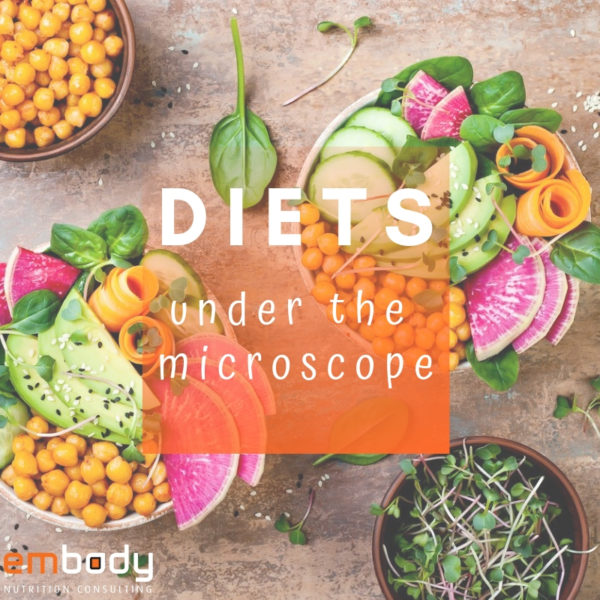With the new year comes an influx of nutrition information, trends, tricks and diets promising to overhaul our body and health for the better. These ‘diets’ promise a lot – but are they all they’re cracked up to be? Let’s take a look…
The word ‘diet’ can come with various meanings. ‘Diet’ may simply encompass the foods selected by someone on a day-to-day basis. People make these dietary choices for various reasons, whether it be cultural, religious, ethical, convenience, taste or preference (or all of the above!). However, the word ‘diet’ is also associated with restriction of energy (calories) or food groups that otherwise play a key role in our bodily functions.
There is a never-ending list of ‘diets’ out there. This article aims to break down two of the most popular diet trends of 2018/2019.
Ketogenic diet
This diet came about as a medical treatment for children with epilepsy in the 20th century but has become popular in more recent years to promote weight loss.
The ketogenic diet is a way of eating that restricts carbohydrates, therefore consuming foods that are high in fat and have a moderate amount of protein. The word ‘keto’ comes from ketone bodies that are produced in the body which are used as a source of energy. Essentially, this diet aims to use and burn fat stores in the body instead of relying on carbohydrates for energy thereby, resulting in weight loss.
This means consuming foods such as meat, fish, nuts, seeds, cream, butter, oils and a limited number of vegetables such as leafy greens. Following a ketogenic diet restricts foods such as breads, pastas, potatoes and all the grains which are healthy and beneficial for our bowel health and movements.
How this diet may help:
- Short terms weight loss
- Removes high-carb junk foods
Why it may not be beneficial for you:
- Highly restrictive both physically and socially
- High saturated fat diet
- Low carbohydrates which are needed for the brain to function properly – therefore may experience brain fog
- Hangry – that feeling when you’re hungry and angry this is a result from low blood glucose levels (it really is a thing)
- Low satisfaction with food – may feel you want to eat more
- Constipation – limiting good sources of carbohydrates means limited fibre which helps us go regularly
Does it work? Yep (wait for it). The ketogenic diet might help you lose weight in the short-term (because it restricts calories!), but whether you are able stick to it long term will be the deal breaker. Also, if you’re an athlete, performing at top speed will always be undertaken better with carbohydrate on board.
Intermittent Fasting
There are many different styles of intermittent fasting that you can follow. The most popular methods include:
- 5:2 diet: 2 non-consecutive days have a calorie restriction, while the other 5 days you eat as per usual.
- 16/8 method: this style involves eating within an 8-hour window and fasting (not eating) for 16 hours. Therefore, you can choose the times that suit you to eat.
- Alternate day fasting: this involves a cycle between one day of ‘fasting’ and one day of eating your regular diet.
Intermittent fasting aims to provide eating windows and non-eating windows which essentially will restrict overall energy intake, therefore resulting in weight loss. On the ‘fasting’ days this can restrict 25% of your regular intake which may result in only 2000 – 3000 kJ (450-700 calories). There is no evidence to say that this style of diet works better than an overall lower calorie diet specifically for weight loss.
Intermittent fasting may be beneficial as the process can make people become more aware of their internal hunger and fullness cues due to the nature of having those fasting times. The restriction of food though, can lead to increase hunger during ‘fasting’ times which could lead to an increased intake during the times we are ‘allowed’ to eat. Therefore, personal preference with how the diet is implemented and whether this diet is sustainable should be considered.
What diet is best?
Diets may help us to lose weight initially, but this can also lead us into a yo-yo dieting cycle:
We restrict food > aren’t satisfied leaving us hungry > eat more than we normally would > leading us to restrict again because we feel guilt or shame for not sticking to an unrealistic diet = resulting in another diet cycle
The diet best for you is one that is realistic, achievable and going to be sustainable long term! Remember, the experience of eating is not the same for everyone and there are many factors that play a role in why and when we eat certain foods. It depends on our activity levels, our day to day life, access to food, individual income, likes/dislikes, our own beliefs and values and much more.
Before jumping on the next diet to shed extra kg’s, try taking it back to basics with fresh food, 5 serves of vegetables, 2 serves of fruit, quality wholegrains and protein sources (and don’t forget to occasionally have your cake, and eat it too).
For more information on the best diet for weight loss, check out our article here.

